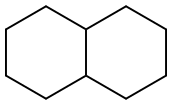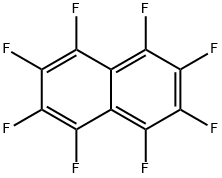A3200612
Decahydronaphthalene , StandardforGC,>99.7%(GC,cis+trans) , 91-17-8
Synonym(s):
Decahydronaphthalene;Decalin
CAS NO.:91-17-8
Empirical Formula: C10H18
Molecular Weight: 138.25
MDL number: MFCD00004130
EINECS: 202-046-9
Update time: 2022-07-08
PRODUCT Properties
| Melting point: | −125 °C(lit.) |
| Boiling point: | 189-191 °C(lit.) |
| Density | 0.896 g/mL at 25 °C(lit.) |
| vapor density | 4.76 (vs air) |
| vapor pressure | 42 mm Hg ( 92 °C) |
| refractive index | n |
| Flash point: | 57 °C |
| storage temp. | Store below +30°C. |
| solubility | 0.006g/l (experimental) |
| form | Liquid |
| color | Clear |
| Odor | Aromatic, like turpentine; mild, characteristic. |
| explosive limit | 0.7-4.9%, 100°F |
| Water Solubility | 6 mg/L at 20 ºC |
| Sensitive | Hygroscopic |
| Merck | 14,2846 |
| BRN | 878165 |
| Henry's Law Constant | 7.00, 8.37, 10.6, 11.7, and 19.9 (x 10-2 atm?m3/mol) at 10, 15, 20, 25, and 30 °C, respectively (EPICS, Ashworth et al.,
1988) |
| Dielectric constant | 2.2(20℃) |
| Stability: | Stable. Incompatible with oxidizing agents. Combustible. May form explosive peroxides. Heat and light accelerate peroxide formation. |
| InChIKey | NNBZCPXTIHJBJL-UHFFFAOYSA-N |
| LogP | 4.2 |
| CAS DataBase Reference | 91-17-8(CAS DataBase Reference) |
| NIST Chemistry Reference | Naphthalene, decahydro-(91-17-8) |
| EPA Substance Registry System | Decahydronaphthalene (91-17-8) |
Description and Uses
Solvent for naphthalene, fats, resins, oils; alternate for turpentine in lacquers, shoe polishes, and waxes; component in motor fuels and lubricants
Safety
| Symbol(GHS) |      GHS02,GHS05,GHS06,GHS08,GHS09 |
| Signal word | Danger |
| Hazard statements | H226-H304-H314-H331-H410 |
| Precautionary statements | P210-P280-P301+P330+P331-P303+P361+P353-P304+P340+P310-P305+P351+P338 |
| Hazard Codes | C,N,Xi |
| Risk Statements | 20-34-51/53-36/37/38-65 |
| Safety Statements | 26-36/37/39-45-60-24/25-23-62-61 |
| RIDADR | UN 1147 3/PG 3 |
| WGK Germany | 1 |
| RTECS | QJ3150000 |
| Autoignition Temperature | 482 °F |
| TSCA | Yes |
| HazardClass | 3 |
| PackingGroup | III |
| HS Code | 29021990 |
| Hazardous Substances Data | 91-17-8(Hazardous Substances Data) |
| Toxicity | LD50 orally in rats: 4.2 g/kg; LC (in air) in rats: 500 ppm (Smyth) |






